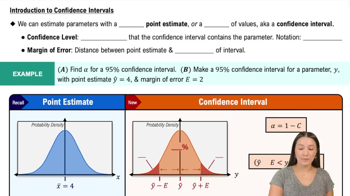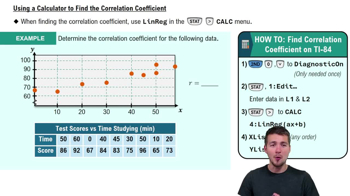Professor Evaluation Scores Listed below are student evaluation scores of professors from Data Set 28 “Course Evaluations” in Appendix B. Construct a 95% confidence interval estimate of for each of the two data sets. Does there appear to be a difference in variation?
Table of contents
- 1. Intro to Stats and Collecting Data1h 14m
- 2. Describing Data with Tables and Graphs1h 55m
- 3. Describing Data Numerically2h 5m
- 4. Probability2h 16m
- 5. Binomial Distribution & Discrete Random Variables3h 6m
- 6. Normal Distribution and Continuous Random Variables2h 11m
- 7. Sampling Distributions & Confidence Intervals: Mean3h 23m
- Sampling Distribution of the Sample Mean and Central Limit Theorem19m
- Distribution of Sample Mean - Excel23m
- Introduction to Confidence Intervals15m
- Confidence Intervals for Population Mean1h 18m
- Determining the Minimum Sample Size Required12m
- Finding Probabilities and T Critical Values - Excel28m
- Confidence Intervals for Population Means - Excel25m
- 8. Sampling Distributions & Confidence Intervals: Proportion1h 12m
- 9. Hypothesis Testing for One Sample3h 29m
- 10. Hypothesis Testing for Two Samples4h 50m
- Two Proportions1h 13m
- Two Proportions Hypothesis Test - Excel28m
- Two Means - Unknown, Unequal Variance1h 3m
- Two Means - Unknown Variances Hypothesis Test - Excel12m
- Two Means - Unknown, Equal Variance15m
- Two Means - Unknown, Equal Variances Hypothesis Test - Excel9m
- Two Means - Known Variance12m
- Two Means - Sigma Known Hypothesis Test - Excel21m
- Two Means - Matched Pairs (Dependent Samples)42m
- Matched Pairs Hypothesis Test - Excel12m
- 11. Correlation1h 6m
- 12. Regression1h 50m
- 13. Chi-Square Tests & Goodness of Fit1h 57m
- 14. ANOVA1h 57m
7. Sampling Distributions & Confidence Intervals: Mean
Introduction to Confidence Intervals
Problem 10.3.15
Textbook Question
Finding a Prediction Interval
In Exercises 13–16, use the following paired data consisting of weights of large cars (pounds) and highway fuel consumption (mi/gal) from Data Set 35 “Car Data” in Appendix B. (These are the same data used in Exercises 9-12.) Let x represent the weight of the car and let y represent the corresponding highway fuel consumption. Use the given weight and the given confidence level to construct a prediction interval estimate of highway fuel consumption.

Cars Use x = 3800 pounds with a 99% confidence level.
 Verified step by step guidance
Verified step by step guidance1
Step 1: Organize the data. The table provides paired data for car weights (x) and highway fuel consumption (y). Identify the given weight (x = 3800 pounds) and note the confidence level (99%).
Step 2: Perform a linear regression analysis. Use the paired data to calculate the regression equation, which is typically in the form y = b0 + b1*x, where b0 is the y-intercept and b1 is the slope. This requires calculating the mean and standard deviation of x and y, as well as the correlation coefficient (r).
Step 3: Calculate the standard error of the estimate (SE). The formula for SE is SE = sqrt(Σ(y - y_pred)^2 / (n - 2)), where y_pred is the predicted value from the regression equation, and n is the number of data points.
Step 4: Determine the prediction interval. Use the formula y_pred ± t*SE*sqrt(1 + 1/n + (x - x_mean)^2 / Σ(x - x_mean)^2), where t is the critical value from the t-distribution corresponding to the 99% confidence level and degrees of freedom (df = n - 2).
Step 5: Interpret the prediction interval. The result will provide a range within which the highway fuel consumption is expected to fall for a car weighing 3800 pounds, with 99% confidence.
 Verified video answer for a similar problem:
Verified video answer for a similar problem:This video solution was recommended by our tutors as helpful for the problem above
Video duration:
3mPlay a video:
Was this helpful?
Key Concepts
Here are the essential concepts you must grasp in order to answer the question correctly.
Prediction Interval
A prediction interval provides a range of values within which a future observation is expected to fall, given a certain level of confidence. It is calculated using the mean of the predicted values, the standard error of the estimate, and a critical value from the t-distribution based on the desired confidence level. This interval accounts for both the variability in the data and the uncertainty in the prediction.
Recommended video:

Introduction to Confidence Intervals
Confidence Level
The confidence level indicates the degree of certainty that the prediction interval will contain the true value of the dependent variable. Common confidence levels are 90%, 95%, and 99%. A higher confidence level results in a wider prediction interval, reflecting greater uncertainty about the estimate, while a lower confidence level yields a narrower interval.
Recommended video:

Introduction to Confidence Intervals
Linear Regression
Linear regression is a statistical method used to model the relationship between a dependent variable and one or more independent variables. In this context, the weight of the car (independent variable) is used to predict highway fuel consumption (dependent variable). The regression equation is derived from the data, allowing for predictions and the calculation of prediction intervals based on the fitted model.
Recommended video:
Guided course

Calculating Correlation Coefficient - Graphing Calculator

 6:33m
6:33mWatch next
Master Introduction to Confidence Intervals with a bite sized video explanation from Patrick
Start learningRelated Videos
Related Practice
Textbook Question
